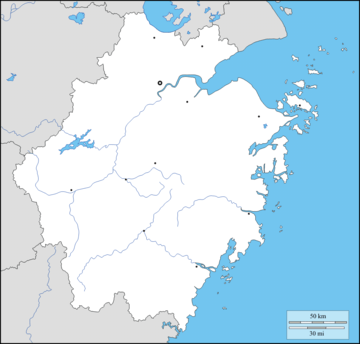Tiantong Temple
| Tiantong Temple | |
|---|---|
| 天童寺 | |
 Tiantong Temple | |
 Shown within Zhejiang | |
| Basic information | |
| Location | Taibai Mountain, Yinzhou District, Ningbo, Zhejiang |
| Geographic coordinates | 29°47′37″N 121°46′49″E / 29.79361°N 121.78028°ECoordinates: 29°47′37″N 121°46′49″E / 29.79361°N 121.78028°E |
| Affiliation | Chan Buddhism |
| Country | China |
| Architectural description | |
| Founder | monk Yi Xing (義興) |
| Completed | AD 300 |
Tiantong Temple (Chinese: 天童寺; pinyin: Tiāntóngsì) is a Buddhist temple located in Taibai Mountain of Yinzhou District, Ningbo, Zhejiang, in the People's Republic of China. The temple covers a total area of 76,400 square metres (822,000 sq ft), with more than 38,800 square metres (418,000 sq ft) of floor space. Tiantong Temple is listed as one of the "Five Chan Buddhism Temples". Tiantong Temple is the cradle of Japanese Buddhism Sōtō.[1][2][3]
History

Jin dynasty
Tiantong Temple was first established by monk Yi Xing (義興) in 300, in the first year of the age of Yongkang of Emperor Hui of Jin.
Tang dynasty
In 732, in the twentieth year of the age of Kaiyuan of Emperor Xuanzong, monk Fa Xuan (法璇) rebuilt it in the mountain valley, and named it "Taibai Jingshe" (太白精舍).
In 757, in the second year of the age of Zhide of Emperor Suzong, monk Zong Bi (宗弼) and Xian Cong (縣聰) removed the temple to the foot of Taibai Peak. Two years later, the Emperor gave the name "Tiantong Linglong Temple" (天童玲瓏寺).
In 841, in the first year of the age of Huichang of Emperor Wenzong, monk Jing (鏡禪師) extended the Temple.
In 869, in the tenth year of the age of Xiantong of Emperor Yizong, the Emperor gave the name "Tianshou Temple" (天壽寺).
Song dynasty
In 1007, in the fourth year of the age of Jingde of Emperor Zhenzong, the Emperor named it "Tiantong Jingde Chan Temple" (天童景德禪寺).
In 1085, in the eighth year of the age of Yuanfeng of Emperor Shenzong, the Emperor bestowed a golden kasaya on its abbot Wei Bai (惟白).
In 1101, in the first year of the age of Jianzhong Jingguo of Emperor Huizong, the Emperor bestowed a title of "Master Fo Guo" (佛國禪師) on abbot Wei Bai.
In 1129, in the third year of the age of Jianyan of Emperor Gaozong, monk Zheng Jue (正覺) became its abbot, he settled there, where he taught Chan Buddhism for 30 years, the temple had more than 1,000 monks. In 1134, in the fourth year of the age of Shaoxing of Emperor Gaozong, a monk's hall which can accommodate thousands of people was built.

In 1193, in the fourth year of the age of Shaoxi of Emperor Guangzong,the Gallery of A Thousand Buddhas was built by monk Xu An (虛庵).
In the period of the Emperor Ningzong (1208 - 1224), Tiantong Temple was ranked third among the "Five Mountains and Ten Temples" (五山十剎).
Yuan dynasty
In 1301, in the third year of the age of Dade of Temür Khan, the Gallery of A Thousand Buddhas was renamed "Chaoyuan Baoge" (朝元寶閣) by the Emperor.
In 1359, in the nineteenth year of the age of Zhizheng of Toghon Temür, abbot Yuan Liang (元良) restored the "Chaoyuan Baoge". One year later, the Emperor bestowed a title of "Shanjue Puguang Xiangshi" (善覺普光祥師) on him.
Ming dynasty
In 1382, in the fifteenth year of the age of Hongwu of Hongwu Emperor, the Emperor renamed it "Tiantong Chan Temple" (天童禪寺).
In 1587, in the fifteenth year of the age of Wanli of Wanli Emperor, a fire destroyed most of its buildings. That winter abbot Yin Huai (因懷) rededicated a small temple on the ruins.
During the reign of Chongzhen Emperor (1631 - 1640), the temple was completely reconstruction by abbot Mi Yun (密雲).
Qing dynasty
In 1659, in the sixteenth year of the age of Shunzhi of Shunzhi Emperor, the Emperor gave thousand gold pieces for reconstruction of the Buddha Hall, and bestowed a title of "Master Hongjue" (弘覺禪師) on abbot Dao Jin (道進).
In 1902, in the twenty-eighth year of the age of Guangxu of Guangxu Emperor, abbot Ji Chan (寄禪) implemented the Reform System of Open Selection of Abbot.
Republic of China

Master Yuan Ying was abbot of Tiantong Temple between 1930 and 1936. During his tenure, he taught Chan Buddhism there, attracted large numbers of practitioners.
People's Republic of China
During the Cultural Revolution, Tiantong Temple was closed, many of cultural relics was stolen, the Buddha statues were burnt by the Red Guards.
In 1979, the local government repaired its buildings.
In 1983, Tiantong Temple was designated as a "Han Area of National Key Buddhist Temples" (漢族地區佛教全國重點寺院).
In 2006, it was listed as a China's national key cultural relic preservation unit by the State Council of China.
References
- ↑ 日本曹洞宗长野县日中友好协会一行参访宁波天童寺. Fojiao (in Chinese). 2015-05-07.
- ↑ 天童寺:禅宗五山第二山 禅门曹洞宗传承地. Ifeng (in Chinese). 2012-01-29.
- ↑ 微雨朦胧 深秋的天童寺有多美?. Zhejiang Online (in Chinese). 2015-11-24.
External links
| Wikimedia Commons has media related to Tiantong Temple. |